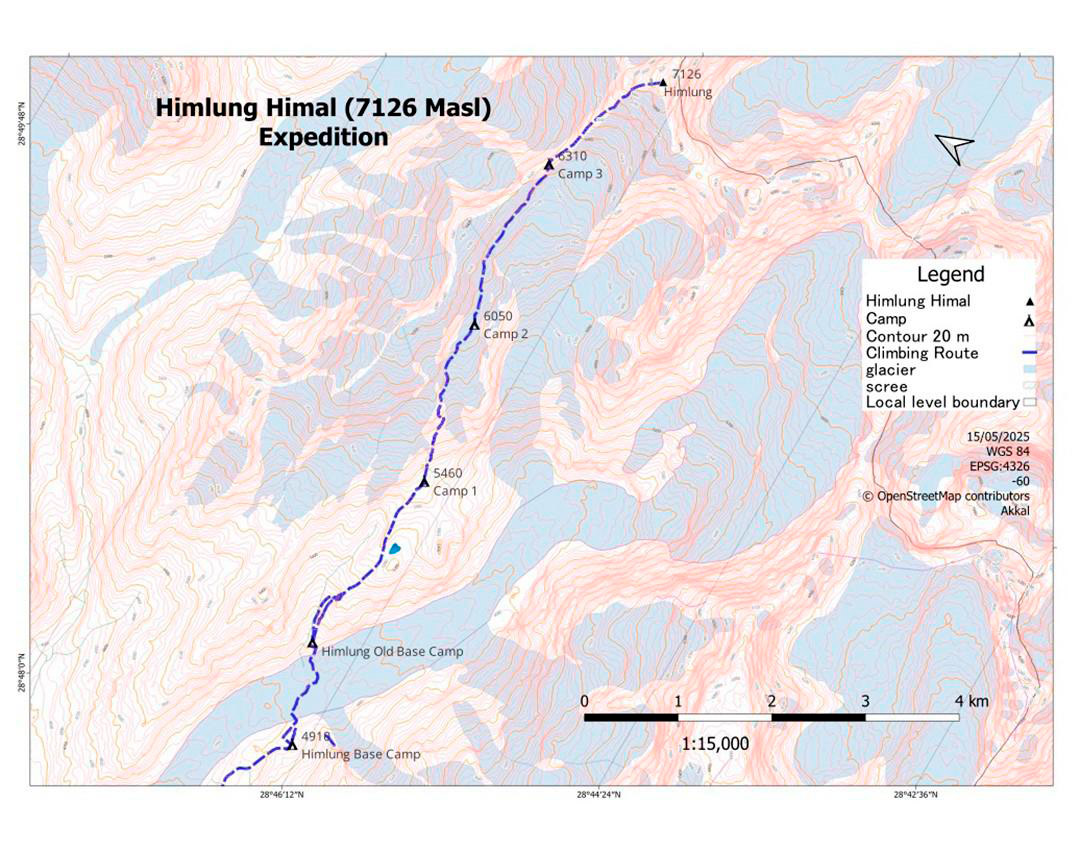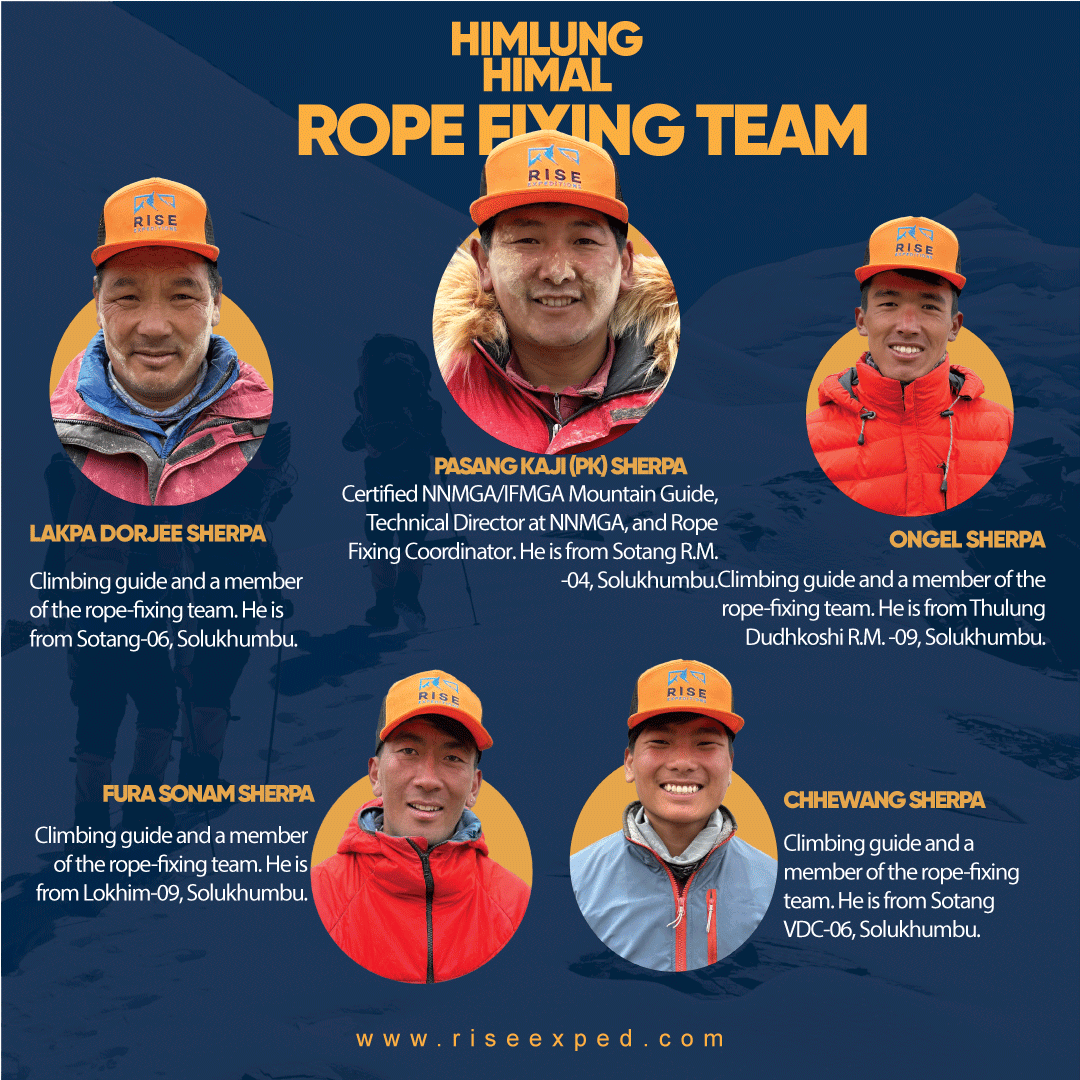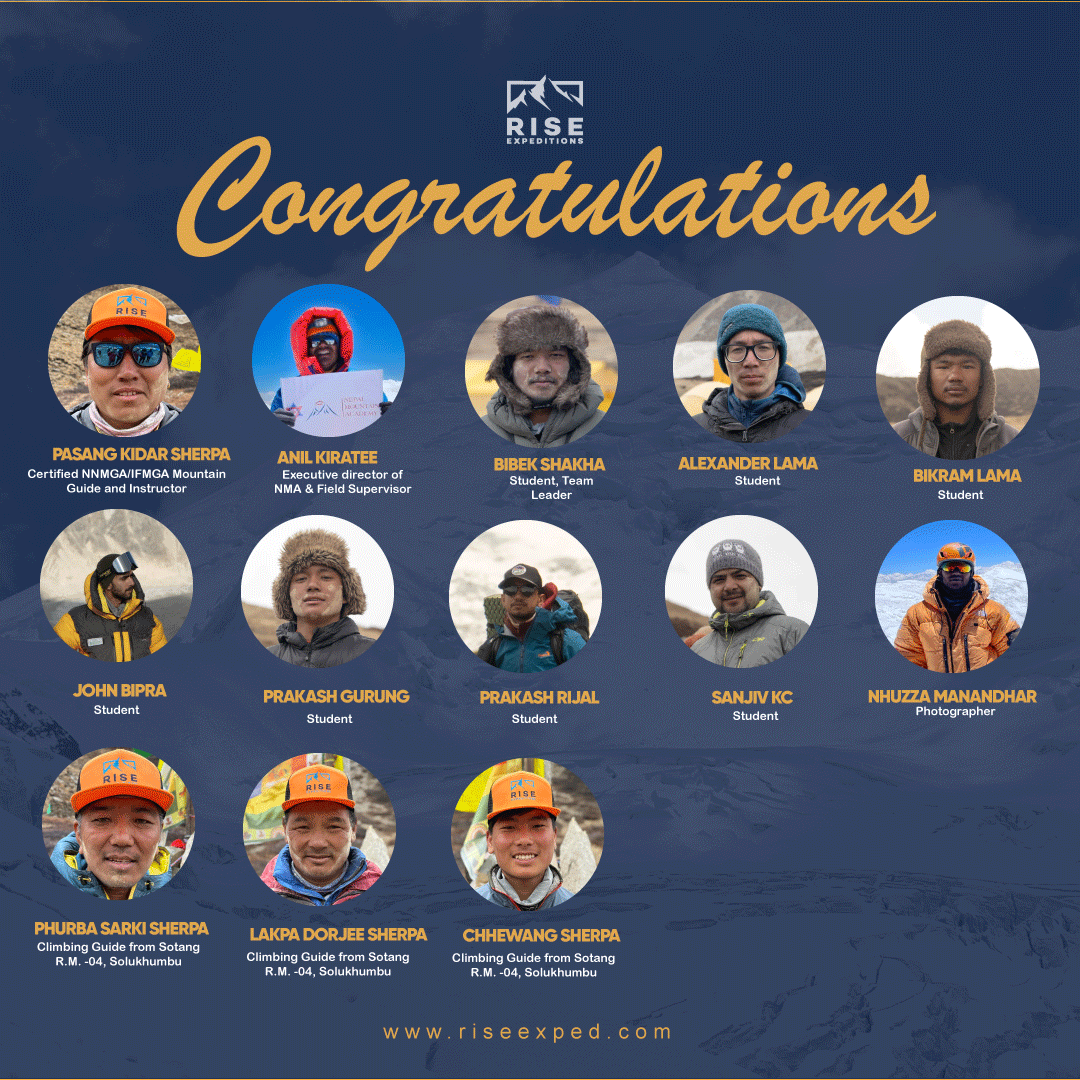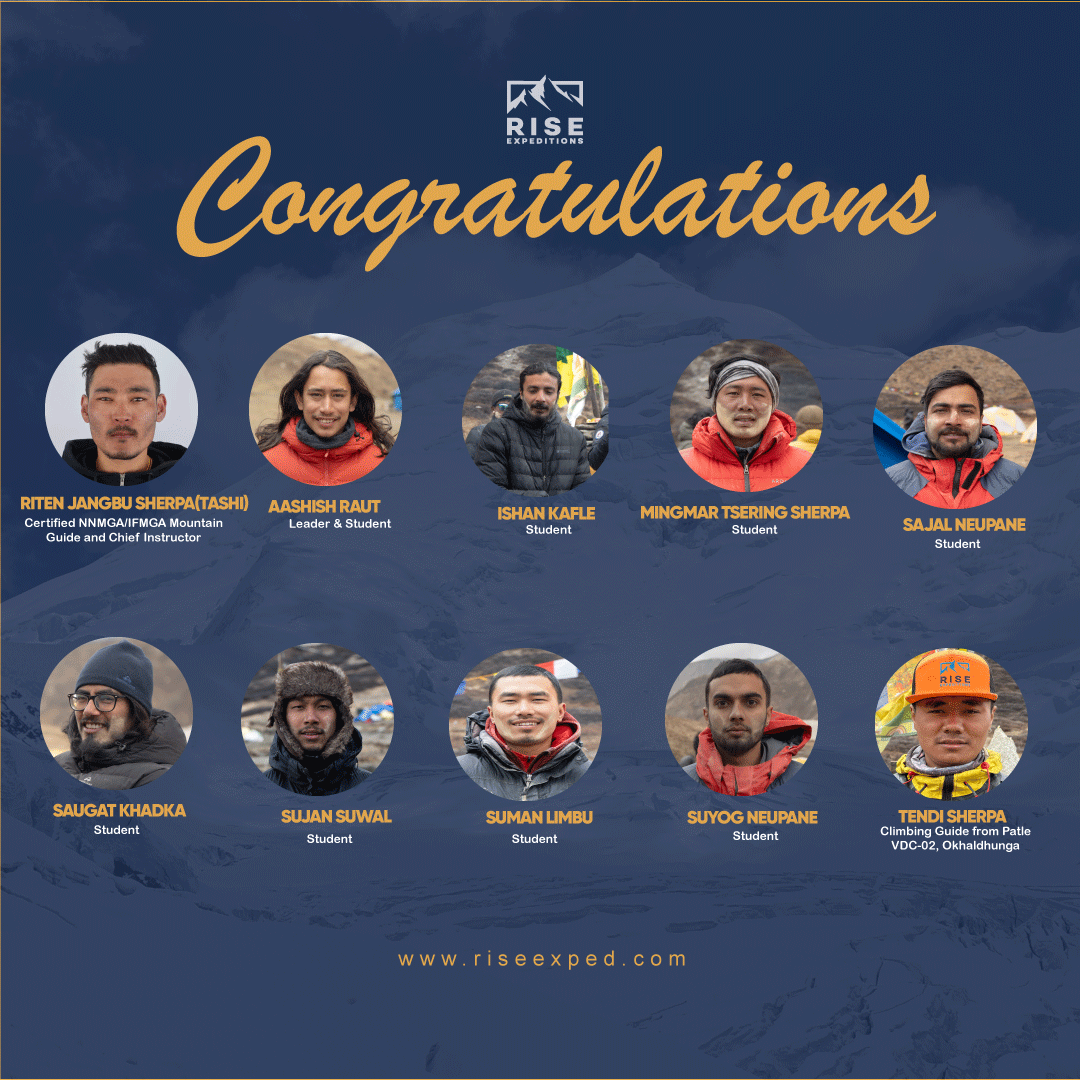In a proud and historic moment for Nepal’s mountaineering education, the Bachelor of Mountaineering Studies (BMS) 2020 batch from Nepal Mountain Academy successfully summited Himlung Himal (7,126 meters). This marks the first time such a large group of students — 15 in total — has climbed a 7000-meter peak as part of their academic curriculum. Out of 22 students in the program, 17 joined the final summit push, and 15 of them reached the summit, achieving an outstanding 88% success rate from Base Camp to the top.
This wasn’t just another expedition — it was part of the official course BMS 801: Practical Training Trip (PTT), where students combine research with real-life high-altitude experience.
From the very beginning to the summit, the entire expedition was organized by Rise Expeditions & Treks Pvt. Ltd.
Our founder, Pasang Kaji (PK) Sherpa — an IFMGA-certified guide, Technical Director of NNMGA, and lead rope-fixing coordinator — took on a double role: guiding both logistics and the students on the mountain.
This is a big leap — not just for the students, but for Nepal’s mountain education as a whole. It’s the first time we’ve seen this level of organization, scale, and professionalism come together in a student expedition on a 7000-meter peak.
And for us at Rise Expeditions, this moment means a lot. It’s not just about reaching the summit — it’s about shaping the future of Nepali mountaineering.
Grab a coffee — let’s take you through the full story.
Himlung Himal (7126m) Introduction
Himlung Himal, situated at 7,126 masl (23,379 feet), is a prominent peak located in the Peri Himal range within Nepal’s remote Naar Phu Valley, close to the Tibetan border. Geographically, it lies at 28° 46′ 18″ North latitude and 84° 25′ 29″ East longitude, northeast of the Annapurna massif. This majestic mountain was first successfully climbed on October 3, 1992, by Osamu Hanai, Akio Koizumi, and Nima Sherpa. The Nepalese government officially opened the region to mountaineering in 1992, making it accessible to expeditions.
Caravan route
The approach to Himlung Himal Base Camp was executed in multiple stages, combining road transport and trekking through remote highland terrain. The logistics and personnel were mobilized as follows:
The expedition commenced in Kathmandu, with the team and supplies transported via bus to Besisahar, the administrative center of Lamjung District. This overland journey, covering approximately 175 km, took around 7 to 8 hours along the Prithvi Highway and Dumre–Besisahar corridor. The road section offered smooth transit conditions suitable for passenger and cargo movement.
From Besisahar, the team transitioned to a 4WD jeep, suitable for off-road terrain, continuing northward through rugged mountain tracks to reach Koto in the Manang District. This leg of the journey required 5 hrs 30 minutes, navigating narrow paths along the Marshyangdi river gorge. All critical expedition gear, food supplies, and equipment were also ferried on this route.
At Koto, the expedition team initiated the trekking phase, entering the restricted and culturally isolated Nar–Phu Valley. The trekking route progressed through:
- Meta: the initial overnight rest point above Koto
- Kyang: a temporary settlement offering panoramic views and highland acclimatization
- Phu Gaon: one of the last permanent villages before reaching alpine zones
This foot journey provided both acclimatization opportunities and cultural immersion, gradually ascending through rocky terrain, river valleys, and glacial features. Between Koto and Meta, the trail offered more than just views — the team came across natural hot water, adding a bit of warmth to their high-altitude journey. The The team acclimatization at Phu village, the group hiked to a nearby viewpoint to assist with altitude adjustment (5000m above base Camp).
The final ascent to Himlung Himal Base Camp (approx. 4910m) was completed on foot from Phu, with the assistance of mules to carry equipment and tents. Upon arrival, our field Staff. established a fully equipped Base Camp with all logistical infrastructure for the upcoming high-altitude operations.
Climbing Route
The base camp is situated at 4910 meters near a stream, with minimal avalanche risk. The route to Camp 1(5460m) involves crossing glaciers, moraines, and small valleys, requiring approximately 3–4 hours. Snow conditions may be challenging, but avalanche danger remains low.
Camp 1 to Camp 2 (6050m)
From Camp 1, the route ascends a scree slope to the glacier’s edge, followed by glacier travel while avoiding crevasses. Fixed ropes are installed on steeper sections to enhance safety. Avalanche risk is continuously monitored and remains low.
Camp 2 to Summit (7126m)
The final ascent from Camp 2 involves a steep ridge with inclines of 45–50°, gaining approximately 1100 meters in elevation. Fixed ropes are installed on exposed icy sections. After summiting, the descent is made back to Camp 1, then to Base Camp.

Rope Fixing Teams and Their Contributions
The success of the Himlung Himal expedition would not have been possible without the hard work, courage, and dedication of our Rope-Fixing Team. Their efforts laid the foundation for a safe and successful climb for the entire expedition.
Led by:
Pasang Kaji (PK) Sherpa
NNMGA / IFMGA Guide, NNMGA Technical Director, and Rope Fixing Coordinator
Team Members:
- Lakpa Dorjee Sherpa – Sotang-06, Solukhumbu
- Ongel Sherpa – Thulung Dudhkoshi RM-09, Solukhumbu
- Fura Sonam Sherpa – Lokhim-09, Solukhumbu
- Chhewang Sherpa – Sotang VDC-06, Solukhumbu
Your hard work ensured the safety and success of every team member on the mountain. We deeply honor and appreciate your strength, dedication, and unwavering commitment to this expedition.

Safety, strength, and dedication in every meter fixed.
The First Summit Team of the Himlung Himal Expedition 2025
The Himlung Himal Expedition 2025 reached a significant milestone on May 15, when the first summit team successfully stood atop the majestic 7,126-meter peak. This remarkable achievement was the result of months of preparation, expert guidance, and unwavering determination.
This team was part of the Fourth Batch students from Nepal Mountain Academy (NMA), undertaking the BMS 801: Practical Training Trip (PTT-6). The expedition forms a vital part of their academic curriculum, providing hands-on mountain climbing experience and helping bridge classroom knowledge with real-world mountaineering challenges.
The 28-day expedition was full logistics by Rise Expeditions & Treks Pvt. Ltd., ensuring logistics, safety, and expert leadership were seamlessly managed throughout the climb. Under the close supervision of experienced instructors and professional climbing guides, the team moved in coordinated efforts to overcome the challenges presented by Himlung Himal.
Summit Date: May 15, 2025, between 10 AM and 11 AM
Expedition Highlights:
- The first summit push marked a successful climb by a well-coordinated team.
- Safety protocols and technical guidance from IFMGA-certified guides ensured a smooth ascent.
- The climb was not only a physical feat but also an academic milestone for the students.
The First Summit Team:
- Pasang Kidar Sherpa – NNMGA/IFMGA Guide, Instructor
- Anil Kiratee – Executive Director and Field Supervisor
- Bibek Shakha – Student, Team Leader
- Alexander Lama – Student
- Bikram Lama – Student
- John Bipra – Student
- Prakash Gurung – Student
- Prakash Rijal – Student
- Sanjiv KC – Student
- Nhuzza Manandhar – Photographer
- Phurba Sarki Sherpa – Climbing Guide
- Lakpa Dorjee Sherpa – Climbing Guide
- Chhewang Sherpa – Climbing Guide

Each member brought strength, skill, and spirit to this expedition, culminating in their triumphant summit. Their successful climb not only reflects personal accomplishment but also exemplifies the power of teamwork, expert mentorship, and rigorous training.
As the first team begins their descent, preparations are underway for the second team’s summit attempt on May 16, 2025.
The Himlung Himal expedition continues to inspire and demonstrate the passion and resilience of Nepal’s mountaineering community and future guides.
Second Team Summits Himlung Himal
The Himlung Himal Expedition 2025 marked a historic chapter on May 16, as the second summit team successfully reached the peak at 1:14 PM. This ascent followed the first summit push on May 15 and further demonstrated the strength, coordination, and dedication of the Fourth Batch students from Nepal Mountain Academy (NMA).
This achievement is part of the BMS 801: Practical Training Trip (PTT-6) — a cornerstone academic course in mountain climbing. Designed to bridge theoretical knowledge with real mountain experience, this course provides students with direct exposure to the challenges and triumphs of Himalayan climbing.
The expedition was made possible with the full support and logistics of Rise Expeditions & Treks Pvt. Ltd., who provided professional guidance, technical support, and all the safety protocols necessary for a successful ascent. Instructors, guides, and students worked together seamlessly, facing altitude, weather, and terrain — and rising above it all.
Expedition Highlights:
- A total of 15 students successfully summited Himlung Himal across both teams — 7 on May 15 and 8 on May 16.
- This is the largest number of NMA students to summit a 7000-meter peak in a single academic season — a proud milestone for Nepal Mountain Academy.
- The second team’s summit further reflects the growing strength of mountaineering education and training in Nepal.
The Second Summit Team (May 16, 2025):
- Riten Jangbu Sherpa (Tashi) – NNMGA/IFMGA Guide, Chief Instructor
- Aashish Raut – Student, Team Leader
- Ishan Kafle – Student
- Mingmar Tshering Sherpa – Student
- Sajal Neupane – Student
- Saugat Khadka – Student
- Sujan Suwal – Student
- Suman Limbu– Student
- Suyog Neupane – Student
- Tendi Sherpa – Climbing Guide

Food and Accommodation on the Himlung Himal Expedition
Nutrition plays a critical role in the success of any high-altitude expedition. At Base Camp, the team was provided with four well-balanced meals daily, complemented by safe boiled water to ensure proper hydration and energy replenishment.
During the trekking phases, accommodations in local lodges offered hearty and nutritious meals to support the physical demands of the journey. Dedicated support staff ensured water safety throughout.
Above Camp I, food provisions shifted to high-energy, easily digestible options such as dehydrated meals, tsampa, nuts, cheese, and energy-rich snacks. Hot meals like chicken curry and soup were served when conditions allowed, supporting endurance and recovery at extreme altitudes.
This careful attention to food and hydration was essential to maintaining the team’s strength, morale, and overall expedition success.
Learning Beyond the Classroom – A Real-World Mountaineering Experience
This expedition was more than just reaching the summit. It was a big part of the students’ academic journey. Climbing Himlung Himal gave them the chance to put everything they’ve learned in classrooms into real use—planning, decision-making, teamwork, leadership, and taking care of one another.
They faced the mountain with humility and courage, and came down with something more valuable than a summit certificate—experience, confidence, and the kind of learning you can’t get from a textbook.
The success of the Himlung Himal Expedition happened because of the hard work and teamwork of everyone involved — from the climbers and guides to the support staff and organizers. Our part was to make sure everything ran smoothly, from planning to providing support, so the team could focus on the climb safely.
We want to thank every single person who played a role in this expedition. Your dedication and effort made all the difference.
As we celebrate this achievement, we’re excited for the future and ready for the next challenges. Together, we’ll keep reaching new heights and making more successful expeditions happen.

